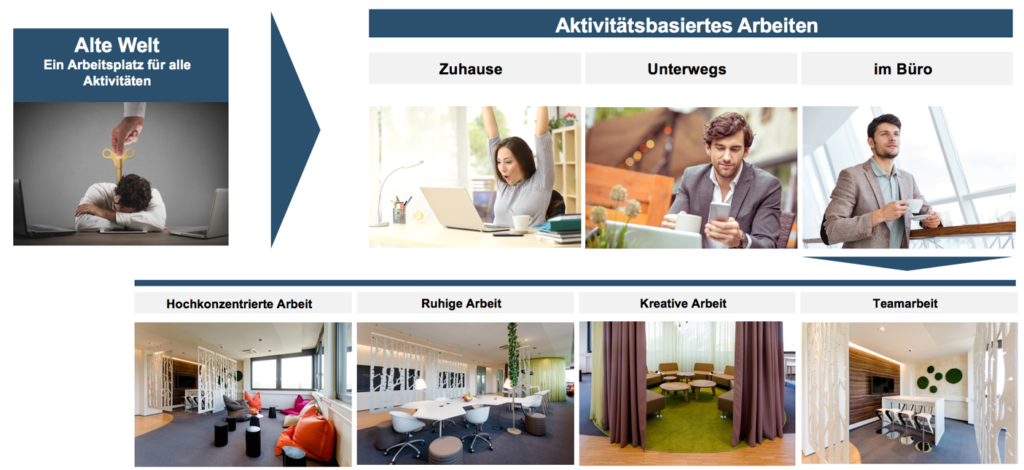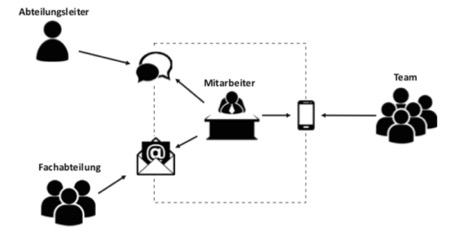The establishment of work 4.0 and agile methods have far-reaching influences on employees in many ways. One of them is employee health. But how do these effects show up in concrete terms? I would like to give four examples and discuss them.
More life satisfaction through work-life balance
A currently much discussed buzzword is work-life balance. Already a Study of universe shows that a good work-life balance is the most important career goal for two thirds of young professionals. But what exactly does work-life balance mean?

When it comes to work-life balance, I am thinking of models such as flexitime, home office and mobile work, for example in the café around the corner. But is that all? To this end, I have held various round tables. The board of one of the largest German trade unions said that you can fix a work-life balance at work location and working hours.
Just a few years ago, leisure time was planned around work. With work-life balance, this statement seems to be completely reversed. So says the union board in one of mine Roundtables on modern work :
“We created the company agreement that working hours are recognized from anywhere, theoretically also from the swimming pool. You document it. You can work from anywhere. ”
Quote from the roundtable by Dominic Lindner, one of the union’s executive directors
It remains to be seen how a work-life balance can affect health. Those who work constantly neglect their private life and social contacts. One suffers from excessive demands and inner unrest. However, if this imbalance becomes permanent, it can lead to mental illnesses such as dizziness, burnout or tinnitus.
More movement through new office concepts
Another concept is what is known as activity-based working. It is about creating special rooms or working environments for each activity of the employee. The following figure shows an example of my current employer. We have created a special environment for every form of work.

The basic idea is situation-oriented rooms that are suitable for routine work as well as for creative tasks and project work. Thus the term shows the “arrangement of the room design based on the activities of the employees”. Famous examples can be found in companies with large campus buildings such as Datev , Adidas and the German Telekom . In my roundtable a manager was present who works in such a new office building and said:
“Every table is available, it is not booked in advance, because ultimately it makes the system even more complex if I had to think about it every evening: Where do I sit tomorrow? That would just be too much of a hassle. And so, in principle, every workplace is free for everyone. I can sit down wherever I want. ”
Quote from the round table by Dominic Lindner, a manager of a sporting goods manufacturer
But what is the impact on health? It is no longer a secret that a sedentary lifestyle harbors major health risks. Side effects are back or neck pain. The typical office worker sits up to 12 hours a day. The creativity of the employees also suffers if the work environment remains the same (e.g. the desk).
With the help of this new work concept, creativity is encouraged by changing location and movement. My experience is that the employee usually changes his place of work every 2 hours in this new work environment, thus massively reducing the stress caused by sitting.
Reading tip: Future work
Less burn-out or bore-out through agile methods
Strict guidelines, monotomy and impotence in the workplace lead to diseases such as burn-out or bore-out. While Bore-Out means being under-challenged by monotonous and boring tasks, Burn-Out is the opposite: being overwhelmed by too many tasks. The following figure shows such small-scale work in which every employee does the same job every day.

Agile methods such as Scrum use a backlog (task list) to ensure that employees have varied work. Tasks are not assigned because the employees pull them from a task backlog and complete them independently.
In my round tables Agile methods have also been discussed and the union’s executive committee has carried out initial studies on them. His first conclusion is:
Our employee survey shows that agile methods are good for employees. Strict processes and guidelines lead to dissatisfaction and stress.
Quote from the roundtable by Dominic Lindner, one of the union’s executive directors
Strict processes and guidelines usually lead to the two diseases of bore-out and burn-down. The symptoms are pretty much the same: listlessness, bad mood, irritability, permanent tiredness, fatigue, weakness and exhaustion. Other consequences are serious illnesses such as dizziness, tinnitus, stomach problems and headaches.
Reading tip: Scrum in corporations
Risk of overstimulation from technology
Overstimulation is a colloquial metaphor for an assumed state of the body in which it absorbs so many stimuli at the same time through the senses that they can no longer be processed and lead to mental overload in the person concerned. ” (Source Wikipedia ).
But what are the effects of overstimulation and why is it relevant in the digital age? To this one said of my participants in the round table:
“I come to the office in the morning and have 40 unread emails. At the same time, when I answer them, I get more messages via Skype, HipChat, etc. “
Quote from Dominic Lindner’s roundtable, a manager in the textile industry
So the point is that a lot of messages and impressions affect the employees and there is a strong psychological stress caused by the technology. The consequences are that the body hardly recovers. As the figure shows, employees are increasingly communicating digitally.

A study of the Hans Böckler Foundation shows that the bigger the
Technostress, the worse your mental health. The consequences are: dissatisfaction, excessive demands, irritability and unreliability, which lead to permanent stress. The effects of stress vary from person to person, but are always harmful to health. The consequences are serious illnesses.
Reading tip: Disadvantages of digitization in the workplace
Risk of being overwhelmed by self-organization
Another risk is that home office and work-life balance also place increased demands on employees. If a manager had previously planned the distribution of tasks and core working hours, the employee must do this himself today. So said one Manager on this in the roundtable :
Not everyone wants to organize themselves and be creative. Some just want a work instruction and then go home.
Quote from the roundtable by Dominic Lindner, a manager in the pharmaceutical industry
The bottom line is that not every employee wants to work completely digitally and in an agile manner, as increased self-organization is not always desired. It should therefore be assessed individually for each employee. Permanent excessive demands in the workplace lead to stress, demotivation, grief, worries and tension. The work is no longer fun, but becomes more and more overwhelming.
Reading tip: Mindfulness in digitization
Conclusion
The article gives studies of agile methods, new office concepts, remote work and technology in companies. The theoretical knowledge is then illustrated by a practical example and implications for the health of employees are given. In summary, the implications are:
- Work-life balance can promote the health of employees and strengthen motivation.
- Strict processes and guidelines lead to stress and frustration, which can be prevented by agile methods.
- New office concepts are a good way to counteract long periods of sitting and encourage creativity.
- New office concepts require a higher level of self-organization from employees and not everyone feels like it.
- Digital work can promote overstimulation and technostress.
tip : I stick to this Subject also to lectures.
Image source: Background photo created by senivpetro – www.freepik.com
[werbung] [fotolia]


